
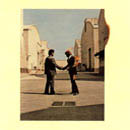
Personnel
Pink Floyd
Pink Floyd - Producer, Recorded at Abbey Road Studios
David Gilmour - Guitar, Vocals
Nick Mason - Drums
Roger Waters - Bass, Guitar, Vocals, Lyrics
Richard Wright - Keyboards, Vocals
Additional musicians
Venetta Field - Vocals, Backing vocals
Roy Harper - Vocals on ?Have a Cigar?
Brian Humphries - Engineer
Peter James - Engineer, Assistant Engineer
Dick Parry - Saxophone
Carlena Williams - Vocals, Backing vocals
Songs List
1.Shine on You Crazy Diamond - 13:40
Part I (Wright/ Waters/ Gilmour)
Part II is (Gilmour/ Waters/ Wright)
Part III (Waters/ Gilmour/ Wright)
Part IV (Gilmour/ Wright/ Waters)
Part V (Waters)
2. Welcome to the Machine (Waters) - 7:31
3. Have a Cigar (Waters) - 5:08
4. Wish You Were Here (Gilmour/Waters) - 5:34
5.Shine on You Crazy Diamond - 12:31
Part VI (Wright/ Waters/ Gilmour)
Part VII (Waters/ Gilmour/ Wright)
Part VIII (Gilmour/ Wright/ Waters)
Part IX (Wright)
Date of released - September 15, 1975
Song and the Album Background
The album, Wish You Were Here was dedicated to Pink Floyd's former member, Syd Barrett, the main theme were absence and alienation (Shine on You Crazy Diamond and Wish You Were Here), and the broadsides against the music industry (Welcome to the Machine and Have a Cigar).
After their highly received Dark Side of the Moon, the making of later Wish You Were Here was kind of under pressure. Their psychotic status could be read in a simple way from the subjects: 'absence' (escape?), 'alienation' (long way home from never ending tour?), and the direct against the music industry.
Shine on You Crazy Diamond was a long piece which enough to fill one side of a LP, and as the first song they wanted to put into the album. The members broke it into 2 long parts, one (Part I to V) acts as an intro and the other (Part VI to IX) acts as an outro of the album, with 3 songs between them.
Storm Thorgerson was long time Pink Floyd graphic guru, he liked to use photos and colleges, his distinct works were Pink Floyd's Dark Side of the Moon and Wish You Were Here.
Follow the main theme of the album, absence, alienation and broadsides against the music industry.
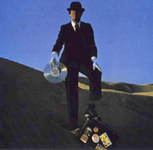
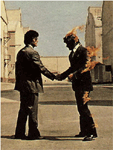
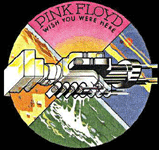
So what you see on the front is 2 businessmen shaking hands and one is being burnt: implying the malignant motives or fear on communications under the mask of friendship. The back is a transparent salesman hawking Pink Floyd albums on the middle of an empty desert: implying the record company knew nothing about the music they are going to sell.
The inner sleeve have 2 picture, a veil (with a hidden face) blowing across an empty grove lined by unremittingly regular rows of trees and a splashless diver diving into the lake. Both are showing a contrary between material and natural, and the theme of absence (hidden faces behind the veil and inside the lake).
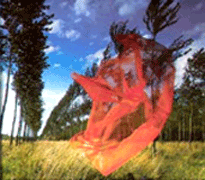

For more symbol on absence, the album was first issued in opaque shrink warp, with a sticker on. Which had machine hands' shaking (similar to the album cover) plus the 4 elements (fire, water, air and earth), that's a contrary on material and natural again.
Musical Analysis
The song is clammy, cosmic, ambience and less motional, it's not a happy song but it's not very sad at all. The images to draw from the song are, like drifting in space, a night in the desert. Beside, I watched a TV documentary, which is about the ants in desert, it took the part I and II for background music, the result is wonderful.
With an atmospheric overture, Pink Floyd themselves used to play it as the intro (the first song) in their concert. The total time duration is 13:40, which, nowadays is impossible to hear it entirely from the radio. In stead, Pink Floyd music doesn't contain large part of vocals, it's suitable for TV/film background music.
There's no key change in the song, begins with G-minor (relative to Bb-major) and until the end.
As a progressive rock piece, with no repetition phrases, there's no obvious structure like pop song. To follow their own divisions, I read it from Part I to V and put few sub parts in it.
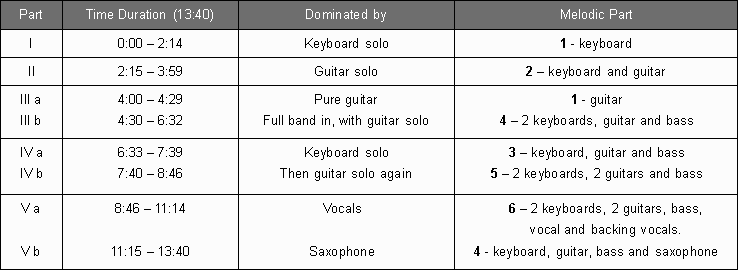
I will see part I and II as an overture, it's because they sound individually. Then part III and IV as a foreshown of the part V, since they have similar chord progression.
Part I (0:00 - 2:14)
The almost motionless synths performance by Wright's synths, the layers are the only instruments that play through the whole song, and provide the main spacey and soft texture. Sure he was playing G-minor scale with something like sawteeth wave.
It's difficult to count the bars no. and tempo in this part, because there's no rhythm sections.
Part II (2:15 - 3:59)
Gilmour's guitar joined Wright's synths, he played the G pentatonic minor gently and bluesy. The blues short notes increased the rhythmic motion with the slow keyboard sound.
The new texture is added, the sound of guitar is warm and clean with some reverb, but it's not thick, I guess it's a fender stratocaster. I can duplicate the sound by the first pickup on my telecaster.
The rhythm session not appeared yet, but there's certain bass pattern played by Wright's keyboard, they are G, D, C, G, D, C, D, G.
Part III
Time Signature: 3/4
Tempo: 144bpm
Total (4 bars drums fill + 32 bars full band + 64 bars guitar solo) 96 bars
Part III a (3:59 - 4:29)
The first 4 notes played by Gilmour started the part III. This guitar was different from the one in part II, with kind of wah wah or some phasing effects. They are Gb, F#, G and E, which was a phrase that played through this part, just called it phrase A. It should be notice that E is not in the key of Gb.
Part III b (4:30 - 6:32)
There are 2 sub parts under part III b, which first is the band played together (32 bars) and then the guitar solo again (64 bars).
After 4 times of phrase A, a drums filling 4 bars, then full band joined. This is the first time the whole band played together, the rhythm session boost up the song obviously. And so we got the time signature and tempo.
Phrase A played in the first beat of the forth bar. Wright's a stark synth playing chords in the first beat of the second bar, harmonic . Which two different texture joining as a contrary. Nick's jazzful drums played few toms fill in and can hear that Waters played chromatic scales in few places.
In the second part of part III b, another guitar joined. It's distorted with a wah wah playing blues solo on the top of the song. It also played short notes but more intense, fast and a bit sharp. I guess it's still a fender stratocaster.
Wright's Hammond came few bands later than the solo, played with phrase A. This added a hot texture to the song and made this part more intense.
Part IV
Time Signature: 3/4
Tempo: 144bpm
Total (48 bars keyboard solo + 2 empty bars + 48 bars guitar solo + 2 empty bars) 100 bars
Part IV a (6:33 - 7:39)
Distorted guitar solo and phrase A dropped together, instead, they played different things. Now one guitar with little distorted played chords in the first beat of the 2nd and 4th bars, like the synth played in the part III. This is not normal rock pattern that used to be in the first beat of the 1st and 3rd bars.
Another guitar was in clean sound played a slightly movement in the right hand side of the speaker.
Also, the hats dropped as well, with the distorted guitar solo, they left a space for Wright's fat and long noted synth solo. This dropped made the song less intense and cooler, the sound chosen by Wright is calm and gentle. All these turned the song to a slightly different mood.
Part IV b (7:40 - 8:46)
The distorted guitar solo and the hats came back, but not phrase A. The 2 guitars in the part IV remained.
The distorted guitar solo stayed in the same sound but involved lower notes than before. Gentle organ played and then a hot Hammond joined few bars when the part was going to end.
Part V
Time Signature: 3/4, 2/4 from the 160th bar
Tempo: 144bpm, 96bpm from the 160th bar
Total (112 bars for vocals + 84 bars for saxophone) 196 bars
Part V a (8:46 - 11:14)
This is a vocals dominated session, which you can read the form easier. There are two sub parts of part V a, each included 2 times of one verse and 1 time of one chorus. Between the two sub parts, there is a bridge has short guitar solo, and then to the second sub parts. There's a A A B C A A B form, also, there's a hookline 'Shine on you crazy diamond' in the last of every verse.

The lead vocals, treated like the one in Dark Side of the Moon, which is slightly phased and feed with reverb. And when got to the hookline and chorus, the three vocalists in the band and the 2 female black backing vocalists (Carlena Williams and Venetta Field) sung together, plus Gilmour distorted guitar and Wright Hammond, that lifted the song up to the highest level. The called and response pattern in some places sounded nostalgic and shown their black influenced in Jazz and blues.
David played not much but few passages between the vocal line, and guitar solo in bridge is actually 2 guitars playing together in 2 octaves/positions in some places. It sounded like a dry distorted guitar rather than modulation effects involved in this part.
The chords below are found from internet, the chords may not right, but the bass notes are ok, the number in the pocket is the time duration in bar.
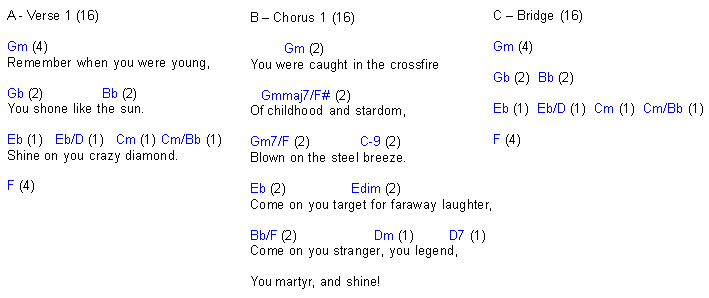
As I said that the key of the song is Bb, the notes used should be within Bb, C, D, D# / Eb, F, G and Ab. From the chords above, you can find that, there's a F# / Gb, which is not in the range. It could be a C blues scale that includes a chromatic F, F# / Gb and G.
And I found it the melodic contents as well, the notes on above the lyrics:

I think it's not a melodic dis-juct melody, the interval between notes not big. And all the notes are in the key of Gb.
Part V b (11:15 - 13:40)
After the vocals is the saxophone solo to end the piece, there are 84 bars totally. While it reached the bar 48th, a fill-in brought the piece to 2/4 and 96bpm. This solo faded in the bar 68th, and the rhythm session dropped out and only the saxophone, guitar remained and the synth noise remained.
In this part, Hammond dropped and only one guitar remained. It was played clean like an acoustic in the right speaker, which the phrase A reappeared after 3 bars of saxophone solo until the fade out. The dropped out of instruments cool down the song gradually and fade out at the end.
Which the synth noise took another connected song in. This time signature changed made a feel from swinging 3/4 to sober and more rhythmic 2/4, which I think it's implying the ending of the song, and the awaking of dream.
The connections between Pink Floyd's songs are always street noise, people chatting muddy, telephone sound, which are great contrary to Pink Floyd sound. I believed this implies the drugged hippies returned to reality.